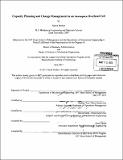| dc.contributor.advisor | Zeynep Ton and David Hardt. | en_US |
| dc.contributor.author | Walker, David, M.B.A. Massachusetts Institute of Technology | en_US |
| dc.contributor.other | Leaders for Global Operations Program. | en_US |
| dc.date.accessioned | 2013-09-24T19:37:43Z | |
| dc.date.available | 2013-09-24T19:37:43Z | |
| dc.date.copyright | 2013 | en_US |
| dc.date.issued | 2013 | en_US |
| dc.identifier.uri | http://hdl.handle.net/1721.1/81024 | |
| dc.description | Thesis (M.B.A.)--Massachusetts Institute of Technology, Sloan School of Management; and, (S.M.)--Massachusetts Institute of Technology, Dept. of Mechanical Engineering; in conjunction with the Leaders for Global Operations Program at MIT, 2013. | en_US |
| dc.description | Cataloged from PDF version of thesis. | en_US |
| dc.description | Includes bibliographical references (p. 151-153). | en_US |
| dc.description.abstract | Purpose - This thesis analyzes the transformation of the Small Components Cell in Pratt & Whitney's aftermarket division through lean manufacturing techniques. The thesis focuses on use of a labor capacity planning model, implementation of a new cell layout, and queuing theory. The project was 6.5 months long, running from June through December of 2012. Findings - In Chapter 4, the capacity planning model shows that demand changes significantly affect cell performance but that the product mix in the cell is even more crucial. The model highlights the best workforce allocations based on a given product mix or demand level. This analysis is expanded in a design of experiment that shows improving employee efficiency is the most effective means of expanding the capacity of the Small Components Cell. Four factors (employee efficiency, absenteeism, overtime, and the duration of employee breaks) have a significant effect on the ultimate capacity of the cell. The design of experiment allows the capacity planning model to be a useful predictive tool. The transformation of the cell into a lean manufacturing flow line requires a significant investment in change management process, including a focus on the logistical details of transformation, continual reinforcement of the vision with the team, and cross-training the workforce. The transformation resulted in a 94% reduction in non-value added part travel, a 72% reduction in flow reversals in the cell, and a 43% reduction in cell exits. Customer satisfaction metrics increase throughout the course of the project as well. Annualized EBIT performance improved by over 40% over the six months of the project, while the costs associated with reworking errors declined by more than 85%. However, on-time delivery of parts to customers failed to meet expectations because of the physical restructuring of the cell and a three month spike in demand which adversely effected cell capacity. Chapter 5 outlines the changes in business metrics, while Chapter 6 discusses recommendations and lessons learned. | en_US |
| dc.description.statementofresponsibility | by David Walker. | en_US |
| dc.format.extent | 153 p. | en_US |
| dc.language.iso | eng | en_US |
| dc.publisher | Massachusetts Institute of Technology | en_US |
| dc.rights | M.I.T. theses are protected by
copyright. They may be viewed from this source for any purpose, but
reproduction or distribution in any format is prohibited without written
permission. See provided URL for inquiries about permission. | en_US |
| dc.rights.uri | http://dspace.mit.edu/handle/1721.1/7582 | en_US |
| dc.subject | Sloan School of Management. | en_US |
| dc.subject | Mechanical Engineering. | en_US |
| dc.subject | Leaders for Global Operations Program. | en_US |
| dc.title | Capacity planning and change management in an aerospace overhaul cell | en_US |
| dc.type | Thesis | en_US |
| dc.description.degree | S.M. | en_US |
| dc.description.degree | M.B.A. | en_US |
| dc.contributor.department | Leaders for Global Operations Program at MIT | en_US |
| dc.contributor.department | Massachusetts Institute of Technology. Department of Mechanical Engineering | |
| dc.contributor.department | Sloan School of Management | |
| dc.identifier.oclc | 857790685 | en_US |
